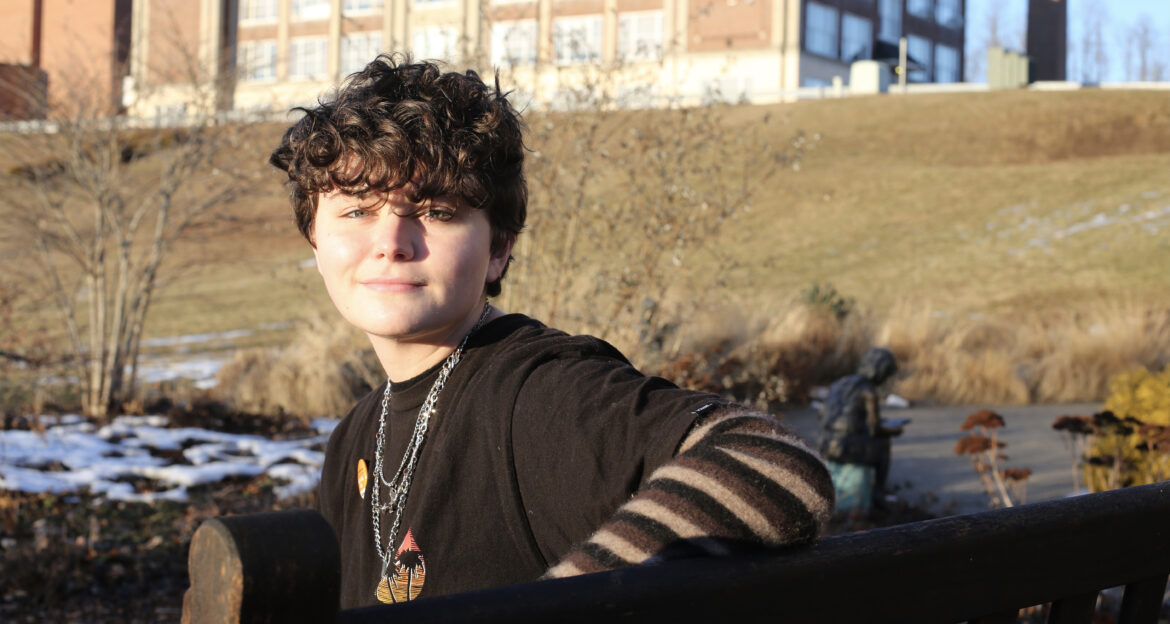By Carol Leonetti Dannhauser
Recommend Tweet Email Print More

Oliver Przech, a high school junior, started wearing a binder in eighth grade. Before wearing a binder, he spent months researching, trying to make sense of himself. Carol Leonetti Dannhauser Photo.
Requests for free breast binders by transgender youths in 2022 have outnumbered supplies at Health Care Advocates International (HCAI) in Stratford, which serves LGBTQ and HIV communities. HCAI received 126 binder requests in the first three weeks of January alone, crushing last year’s numbers and temporarily wiping out inventory. The group sent out 190 binders in all of 2021. A quarter of them went to Connecticut youths, with the rest shipped nationwide and beyond.
“The numbers are jumping because there is such a need,” says Tony Ferraiolo, the Youth & Family Program director at HCAI. He began the binder program on his own before working with HCAI because he knew from experience the difference a binder can make in a young person’s life. “When you give a child hope for a better life, they won’t want to take their life. When we give them a binder, they’re walking tall. It is literally life-saving.”
Chest binders compress breasts to give the appearance of a flat chest. For transgender males who were designated female at birth but who identify as male, developed breasts can trigger body dysphoria so debilitating that it can lead to severe depression and worse. “Half of these kids attempt suicide,” Ferraiolo says, citing a finding from a 2018 report by the American Academy of Pediatrics. “Way more than 50% do self-harm. One way we can minimize this is to provide them with what they need.”
As soon as Oliver Przech, a 16-year-old junior at Farmington High School and president of the school’s Gender Sexuality Alliance, learned about HCAI’s free binder program in January, he spread the word on Google Classroom. He’d started wearing a binder in secret in the spring of eighth grade, and it helped him survive the school day without paralyzing fear. He wanted to provide that help to others.
“As much as I’d like to, I work a minimum-wage job and can’t afford to buy a binder for everyone who needs one,” Przech said one afternoon during a brief break from his after-school job at the Farmington public library, his one place of refuge during years of internal tumult.
“I knew that wearing a binder was going to make me feel better mentally. I was able to order one on my own and kind of kept it hidden and just wore it to school every day. Seeing yourself in the mirror and seeing the body that you want looking back at you—seeing something that more reflects how you feel—is very, very beneficial and very helpful just for mental well-being.”
— Oliver Przech
Literally minutes after he posted about the free binders, requests from classmates landed in Ferraiolo’s in-box.
“Oliver is a superhero to me,” Ferraiolo said. “He knows what it meant to be in the darkness. But he also knows what it’s like to put a binder on and be in the light. I know what it’s like to be that transgender kid and not feel like you’re heard. Oliver is providing hope.”
Care Under the Radar
Christy Olezeski, Ph.D., a child and adolescent psychologist at the Yale School of Medicine whose research and training focused on trauma, found herself working increasingly with clients who questioned their gender. “I was talking to one of my supervisors and asked a very innocent question: Who is providing health care to the trans community, specifically kids and adolescents?”
At best, the answers were anecdotal, so Olezeski set out to learn more. She reached out to Yale endocrinologists, who handle hormone therapy for transgender patients. They enlisted folks from legal and billing, from the medical ethicist and a transgender chaplain. The team slowly but surely created an “under the radar” gender clinic, where patients would see an endocrinologist and a mental health professional during the same visit.
Olezeski and crew offered services for half a day each month in 2018. But demand kept increasing, and the service kept growing. So, last year, the Yale Pediatric Gender Program, which is now official and Olezeski now directs, added clinics in Old Saybrook and Trumbull in addition to New Haven. Patients range in age from 3 to 25. “We have about 400 kids that we’re seeing currently,” Olezeski says. About 57% identify as a boy or man, 27% as a girl or woman, 13% as non-binary and 3% as other. The next available appointment for a new patient is in June of 2023. About 220 people are on the waiting list.
For transgender males, puberty can prove paralyzing with its periods and breasts. “They call [breasts] ‘bumps’ or ‘these things.’ It’s really dysphoria-inducing,” Olezeski says. In a restaurant, at school, in family gatherings, out on the street, enlarged breasts identify a person as female. But inside, the person is thinking, “But this is not who I am!” Olezeski says.

“A lot of times, there is a really strong discomfort, potentially this repulsion, with this part of the area. Many people cannot feel like they’re in their body. It’s a physical sensation. They can’t take a shower. They steam up the room so they can’t see. We talk to them about getting a loofah on a stick because they can’t touch that area.”
— Christy Olezeski
Binders can help. Constructed out of nylon, cotton, Spandex and other stretchable, breathable materials, the garments, which cost around $35, are designed to compress and disperse breast tissue to help convey a flat-chest appearance. A binder can look like a vest, a sports bra, a tank top, an undershirt. Many of HCAI’s binders are donated in bulk by Underworks in Miami. HCAI pays to ship them to people in need. Binders are worn while swimming, at the gym, in school, to sleep—many young transgender males credit binders with helping them survive the day.
Getting Dressed Without Pain
Although binders aren’t supposed to be worn for more than eight hours each day, wearers sometimes trade their physical well-being for their emotional health, even sleeping in them. Folks who don’t have access to binders have been known to fashion their own wrap out of Ace bandages, duct tape, plastic wrap. These issues are concerning to Janine Stoner, an occupational therapist at Middlesex Health in Middletown, which runs the Center for Gender Medicine and Wellness. “Nobody really teaches anybody how to bind,” Stoner says. “I always think of preschoolers who play dress-up—nobody plays dress-up with a binder, so where are you supposed to learn these things? People learn either from a friend or from the internet.”
During Middlesex’s 2019 annual Day of G.I.F.T.S. (Gathering Information for Transgender Services), Stoner discovered that “80 to 90% of people who use binders had a negative effect,” ranging from skin irritation to constricted breathing to pain in the shoulders, chest and rib cage. “There was a whole host of discomforts. Everybody had something.” This troubled Stoner, an occupational therapist whose goal is to “make people independent in their daily life needs. It should not be painful to get dressed, to represent who you are in a comfortable way.”

Janine Stoner Photo Courtesy of Middlesex Health.
“I use an incentive spirometer and have them take a deep breath, and I measure. When they have the binder on, I make sure they have enough room in the axillary region and make sure it’s not digging between the ribs. It’s about being safe but effective,” says Stoner, who has been an occupational therapist for 30 years. “It’s a new, emerging aspect of my job. The transgender community has been marginalized by the medical community. I want to make sure I have everything I need for all people.”
Those are reassuring words for Liam Cohen of Bridgeport, who was designated female at birth but identifies as a “trans, non-binary guy” and prefers the gender-neutral pronoun “they.” But unfortunately, Cohen, 19, has found little understanding among doctors.
“One of the things that’s very disappointing is how few doctors know about trans issues and trans mentality, the psychology behind being trans and having gender dysphoria and how that relates to health care in their specific area,” says Cohen, a freshman at the University of Connecticut. “As soon as I mentioned that I wanted to talk to my ob-gyn about binding because I wanted to make sure to bind safely, they didn’t know anything about it. My yearly doctor didn’t know much about it either. One thing that’s really disappointing is how few health care professionals know about different gender identities and how to handle having trans patients.”
Cohen’s greatest source of dysphoria is their chest. “I’ve never felt comfortable having a chest out there. It’s like saying, ‘Hey, I’m a girl, sexualize me.’ That’s how it’s been in my brain, and I’ve just always hated that. I felt severely uncomfortable—even in my own home—with my chest. It’s like having a scab; it feels wrong. That’s why I bind.”
Cohen turned to the internet to learn about binding. They certainly couldn’t mention anything about it in their ultra-Orthodox Jewish home, where “severe homophobia and transphobia” was woven into the culture.
“I was literally taught in my classes that being queer is wrong. I didn’t know that trans people existed. In the eighth grade, before I knew that gay was a thing, I remember wondering was it possible that every single person out of 7.8 billion people is going to love the ‘opposite gender’? When I got older, I wondered was it possible that every single person in the world is happy being the gender born into the body they were given? In my own subconscious I was trying to grapple with the things going on inside of my own brain when I didn’t have the words for what I was experiencing.”

Liam Cohen of Bridgeport said it was disappointing how few doctors know about “trans issues and trans mentality.” Carol Leonetti Dannhauser Photo.
“I only gave myself the freedom to explore my sexuality and my gender identity once I left the community, so I could be analytical from a positive place,” Cohen said. Sadly, many family members refuse to accept this new identity. “They want me to put on a skirt and pretend I’m their granddaughter—not their grandchild, but their granddaughter,” Cohen said, their voice breaking.
The youth found support in an unexpected place: the online video gaming community, where a player’s gender was whatever they announced it to be. During this period of exploration, Cohen bought a traditional binder and tried it on. “Actually, I didn’t like it. It would start to hurt. It was hot, and I felt suffocated. As a very active person, I very much disliked that. So, I thought, well, maybe I’m just not binding; I’m just going to be like this forever.”
Then they discovered TransTape, a thin, waterproof tape made mostly of cotton with a little Spandex woven in. Cohen wears the tape stretched across their chest, day and night, including in the shower. “It makes me feel just straight-up euphoric! I look at myself in the mirror and because I’d gone so long having my body be the wrong way, for it to all of a sudden be the way it’s supposed to be, it gives me so much self-confidence that it makes me want to stand tall and proud, as opposed to just hiding.”
And this is the main point of binding, says Yale’s Olezeski: To help youths present themselves to the world with confidence, versus wearing bulky jackets inside the classroom or too-big sweatshirts to the gym. Or not going out at all. HCAI supplies the Yale gender clinic with free binders. “It’s been really nice to have them for a show and tell,” Olezeski says. “When kids try the binder on in the clinic, you see their faces, and they say, ‘Oh my God, this is what I’m supposed to look like!’”
Binders are just a temporary fix for most youths Olezeski works with. According to the doctor, 90-95% of the clinic’s trans-masculine and non-binary youth want to eventually have “top surgery,” which is the surgical removal of breast tissue. In Connecticut, most gender-affirming surgery is paid for by health insurance.
In the meantime, though, the binders are a lifeline. Przech reported that some of his classmates “teared up” when they put on a binder for the first time. “They realized, ‘I am not the only one going through this. There are other people like me,’” he says. “We had so many students who, because of the binders, could just feel like themselves in their body, maybe for the first time ever.”
For information on Health Care Advocates International, Stratford go here.
Support Our Work
The Conn. Health I-Team is dedicated to producing original, responsible, in-depth journalism on key issues of health and safety that affect our readers, and helping them make informed health care choices. As a nonprofit, we rely on donations to help fund our work. Donate Now


